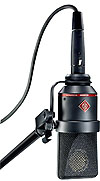|
Neumann TLM
170R Switchable Studio Microphone |
|

Product Code: TLM170R


|
The TLM 170 R*
was the first microphone to use the successful fet 100 technology. Along with a
balanced, transformerless output stage it features extremely low self-noise and
an impressive dynamic range.
Five directional characteristics are selectable by means of a rotary switch. In
the sixth position, marked "R", the directional patterns can be controlled
remotely with the N 248 power supply. There is no special cable necessary for
this purpose.
The microphone has at its rear a 10 dB attenuation switch for extremely high
sound pressure levels, and a high-pass filter to suppress structure born noise.
Applications
The TLM 170 R condenser microphone is a large diaphragm microphone with multiple
polar patterns. Its sound has a very transparent characteristic, in contrast to
some of our other microphones that have a distinct personality.
Therefore, this microphone is used for many diverse applications in professional
recording studios, in broadcasting, film and television, and for
semiprofessional productions. The polar patterns can be selected either at the
microphone itself, or controlled remotely through the special N 248 power
supply.
Acoustic features
The microphone is addressed from the front, marked with the Neumann logo. The
large diaphragm capsule inside the headgrille has a very smooth frequency
response for all polar patterns over a wide acceptance angle. The curves are
flat and parallel to the 0� frequency curve up to 10 kHz within an angle of �
100�.
As a result the TLM 170 R has a very even diffuse-field response for all polar
patterns. This is important in a reverberant environment, as more reflections
arrive at the microphone from different directions. The acoustic information is
not affected in its tonal quality when recorded by the microphone. This
characteristic is achieved without resorting to corrective resonance effects.
Therefore, the microphone maintains an excellent impulse response reproducing
all transient phenomena of music and speech without any coloration. The capsule
is elastically mounted to avoid any structure borne noise that could interfere
with its operation.
Polar patterns
In addition to the usual directional polar patterns: omnidirectional, cardioid,
and figure-8, we have added a hypercardioid and wide-angle cardioid
characteristic. When compared to the standard cardioid pattern, the
hypercardioid characteristic suppresses sound from the side more efficiently.
The wide-angle polar pattern is especially useful to record large sound sources.
Remote control
The N 248 controls the polar pattern remotely by varying the phantom voltage.
The range is � 3 V of the nominal 48 V value. (According to DIN standard a range
of � 4 V is permissible.)
The rotary switch on the microphone must be in the position R (= remote
control). In this switch position the TLM 170 R microphone analyses the absolute
value of the phantom power and selects the corresponding polar pattern. A
standard 3-pin microphone cable is used, similar to the microphone's
conventional operation. Cable lengths may be up to 300 m (1000 feet).
Electrical features
The letters TLM stand for "transformerless microphone". With TLM technology the
usual output transformer is replaced by an electronic circuit. As with
traditional transformers, it ensures good common mode rejection, and prevents RF
interference, that may influence the balanced audio signal.
Use on tripods
The TLM 170 R is provided with a tilting side bracket to attach the microphone
to booms or stands. The bracket is equipped with rubber elements that
effectively protect the microphone from mechanical shock. If necessary, it can
be mounted on the other side of the microphone as well.
When using the IC 4 cable (for example to suspend the microphone from the
ceiling with the MNV 87 auditorium hanger), the bracket and its holder need to
be removed. The microphone can then be connected to the swivel mount connector
of the cable.
Filter and attenuation
The TLM 170 R microphone has a 10 dB attenuation switch to prevent the input of
the following unit from being overloaded. A second switch at the rear allows to
attenuate the frequency response below 100 Hz to suppress undesired structure
borne noise.
Operational safety
All exposed surfaces of the capsule, including the diaphragms, are at ground
potential. This technology makes them highly immune to electrical and
atmospheric interference and contamination through dust particles. |
� Local and
remote controlled large diaphragm microphone
� Pressure-gradient transducer with double membrane capsule
� Five directional characteristics: omni, wide angle cardioid, cardioid,
hypercardioid, figure-8
� Patented circuitry for remote and local switching of directional
characteristics
� Switchable low frequency roll-off and 10 dB preattenuation
� Tiltable, elastically suspended bracket mount |
| Acoustical
operating principle |
Pressure gradient
transducer |
| Directional
pattern |
Omnidirectional, wide angle
cardioid, cardioid, hypercardioid, figure-8 |
| Frequency
range |
20 Hz ... 20 kHz |
| Sensitivity
at 1 kHz into 1 kohm |
8 mV/Pa |
| Rated
impedance |
50 ohms |
| Rated load
impedance |
1 kohms |
| Equivalent
noise level, CCIR1) |
26 dB |
| Equivalent
noise level, A-weighted1) |
14 dB-A |
|
Signal-to-noise ratio, CCIR1) (rel. 94 dB SPL) |
68 dB |
|
Signal-to-noise ratio, A-weighted1) (rel. 94 dB SPL) |
80 dB |
| Maximum SPL
for THD 0.5%2) |
144 dB |
| Maximum SPL
for THD 0.5% with preattenuation2) |
154 dB |
| Maximum
output voltage |
10 dBu |
| Supply
voltage (P48, IEC 61938) |
48 V � 4 V |
| Current
consumption (P48, IEC 61938) |
3 mA |
| Matching
connector |
XLR3F |
| Weight |
625 g |
| Diameter |
60 mm |
| Length |
152 mm |
|
|
|
|
|
|
| |
|
|